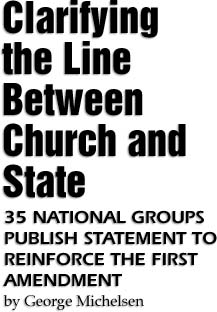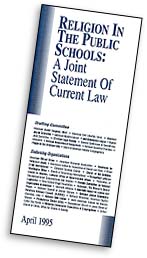


 or millions of young Americans, education and religion are matters of vital interest in their developing lives. But they can also be sources of explosive — but needless — controversy when these two interests seem to collide. Certain religious beliefs can seem unwelcome in school; educational activities can introduce anti-religious elements or beliefs which are in opposition to a child’s faith; even something as simple as praying in school can erupt into contentious disagreement and debate.
or millions of young Americans, education and religion are matters of vital interest in their developing lives. But they can also be sources of explosive — but needless — controversy when these two interests seem to collide. Certain religious beliefs can seem unwelcome in school; educational activities can introduce anti-religious elements or beliefs which are in opposition to a child’s faith; even something as simple as praying in school can erupt into contentious disagreement and debate.
But again, these problems are almost entirely needless — a product of misconception and misunderstanding about how religion and schools can and should co-exist.
A broad coalition of religious and civil liberties groups, including the Church of Scientology International, recently formulated and published comprehensive guidelines to make clear the legal rights of students to express religious beliefs and ideas in public schools.
The document, entitled Religion in the Public Schools: A Joint Statement of Current Law, is based on decisions in church-and-state litigation matters which have defined the constitutionally protected right to religious freedom.
In a speech in July, President Bill Clinton praised the joint statement as “wise and thoughtful” noting that those responsible for the statement “put aside their deep differences and said: we all agree on what kind of religious expression the law permits in our schools.”

The publication emerged as a result of concerns that religious freedom is being curtailed in public schools by school officials who do not have a clear understanding of church-state issues under current case law. These concerns arose from numerous incidents, including the following:
- Schoolchildren in North Dakota were asked to draw a poster on a subject important to them. A young girl presented a thoughtful creation depicting an American flag and a cross with the caption, “Does the Son shine in your school?” Because of the caption, the principal banned the poster from the school display.
- In a Maryland school, a boy sat in his classroom listening to a speaker from a hate group who had been invited to speak about minority religions. Horrified when his religion was denounced, he raised his hand and spoke out in its defense. Some students were shocked to find others in their school belonged to non-traditional religions. Due to the speech from the hate group member, the boy found himself shunned by some of his friends.
- In another school, a girl quietly folded her hands and bowed her head to say grace before eating lunch. The lunch monitor ordered her to stop praying. The girl, confused and frightened, ran crying from the lunch room.
To date, school officials, government leaders, parents, teachers and students have had no firm guidelines regarding acceptable religious practice or discussion in public schools.
To remedy this, the coalition of 35 organizations spanning the ideological, religious and political spectrums compiled and endorsed the joint statement. It carefully lays out in the form of practical guidelines the rights of students as supported by the Constitution and current law in the United States.
Chaired by the American Jewish Congress, the coalition includes the Church of Scientology International, National Council of Churches, the National Association of Evangelicals, the Baptist Joint Committee, Americans United for Separation of Church and State, the National Sikh Center, B’nai B’rith International, the General Conference of Seventh-day Adventists, the American Muslim Council and the Presbyterian Church (USA).

Upon the release of the statement, U.S. Secretary of Education Richard Wiley commented, “I am encouraged by the spirit of cooperation that continues to grow among religious faiths around their ongoing effort to find common ground on the issue of public education and religion. The release of this “Joint Statement” is one more sign that groups which have historically held different perspectives on issues involving religion and public education are working hard to bring a new spirit and tone of goodwill to this often highly charged dialogue....
“We need to find new rules of public engagement, and there is no area where we need to extend ourselves more to lower our voices and respect the civic rights of all Americans than in the space where religion meets public education. In that spirit, I urge other religious faiths, educators and civil rights groups to carefully consider the work and effort behind this document.”
Rabbi David Saperstein, director of the Religious Action Center of Reform Judaism, stated, “To the teacher who sees nothing wrong with leading the class in a daily prayer we say: ‘Read this document.’ To the teacher who wrongly prohibits a student from quietly saying grace before meals, we say: ‘Read this document.’ To the principal who allows a student, under the guise of a class assignment to conduct a religious service during class time, we say: ‘Read this document.’ And to Members of Congress, state and local officials, and some religious leaders — across the political spectrum — who are tempted to play to the religious fervor of some segments of America without regard for what the law actually requires or prohibits, above all to you, we say: ‘Read this document.’”
Rev. Susan Taylor of the Church of Scientology commented, “The joint statement lays out a mature and responsible set of guidelines toward achieving the tolerance and respect Americans should have for all their fellow Americans. It also speaks strongly to those outsiders who wish to make the public school system a platform for hatred and discrimination against any religion.”
The coalition is optimistic that many cases can be resolved with knowledge and use of current law, rather than creating divisive debates over religious freedom issues and creating more court cases.
The full text of the joint statement is produced here for Freedom readers. Additional copies may be obtained from any of the endorsing organizations or by writing to the Office of Public Affairs, Church of Scientology, 1701 20th Street N.W., Washington, D.C. 20009.

 The Constitution permits much private religious activity in and about the public schools. Unfortunately, this aspect of constitutional law is not as well known as it should be. Some say that the Supreme Court has declared the public schools “religion-free zones” or that the law is so murky that school officials cannot know what is legally permissible. The former claim is simply wrong. And as to the latter, while there are some difficult issues, much has been settled. It is also unfortunately true that public school officials, due to their busy schedules, may not be as fully aware of this body of law as they could be. As a result, in some school districts some of these rights are not being observed.
The Constitution permits much private religious activity in and about the public schools. Unfortunately, this aspect of constitutional law is not as well known as it should be. Some say that the Supreme Court has declared the public schools “religion-free zones” or that the law is so murky that school officials cannot know what is legally permissible. The former claim is simply wrong. And as to the latter, while there are some difficult issues, much has been settled. It is also unfortunately true that public school officials, due to their busy schedules, may not be as fully aware of this body of law as they could be. As a result, in some school districts some of these rights are not being observed.
The organizations whose names appear below span the ideological, religious and political spectrum. They nevertheless share a commitment both to the freedom of religious practice and to the separation of church and state such freedom requires. In that spirit, we offer this statement of consensus on current law as an aid to parents, educators and students.
Many of the organizations listed below are actively involved in litigation about religion in the schools. On some of the issues discussed in this summary, some of the organizations have urged the courts to reach positions different than they did. Though there are signatories on both sides which have and will press for different constitutional treatments of some of the topics discussed below, they all agree that the following is an accurate statement of what the law currently is.

